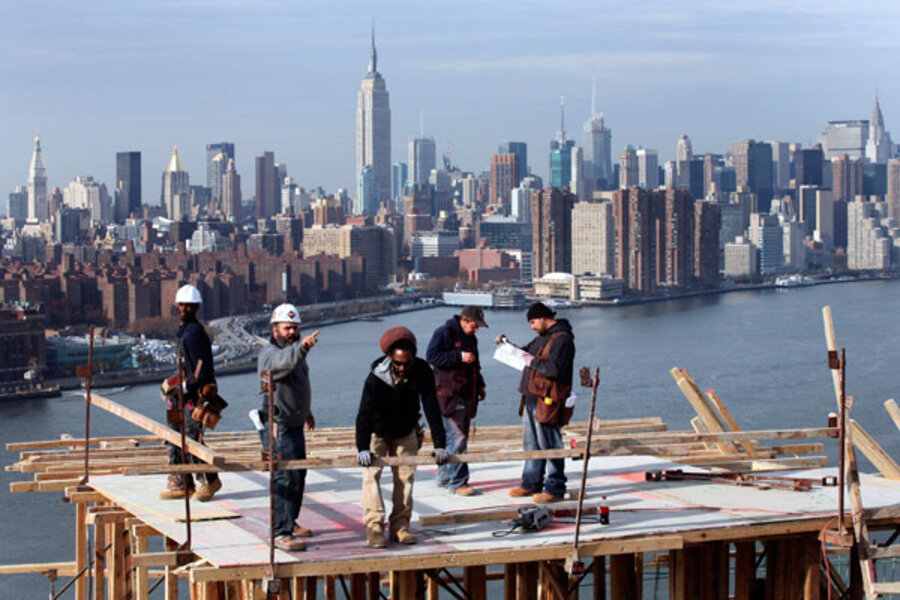New York Mayor de Blasio unveils sweeping plan to address housing crisis
Loading...
| New York
For the past decade, residential real estate in New York City boomed with gleaming-glass new high rises, even as monied suitors battled just to make a long-shot bid on Park Avenue condos with a penthouse view.
But even as luxury housing flourished in the city as its financial sectors churned out money in record-setting amounts, a family of four looking for an affordable two-bedroom walkup often found the market not nearly so robust.
This was one of the reasons New York Mayor Bill de Blasio campaigned with the effective slogan “a tale of two cities” last year, promising to bring the city’s one-sided housing prosperity to those struggling in an economy still sluggish for the poor and middle income classes.
So on Monday, Mayor de Blasio unveiled a 10-year, $41 billion investment plan that would add or preserve about 200,000 affordable apartments for the city’s less affluent. Calling it “literally the largest and most ambitious affordable housing program initiated by any city in this country in the history of the United States of America,” the mayor announced plans to double the capital budget for the city’s housing agency, create a flexible zoning strategy for developers, and begin an immediate ground-up, neighborhood-by-neighborhood survey to find the best places to spur further affordable housing development.
“This plan, over the next 10 years, will create opportunity for so many people who are currently being priced out of our city,” the mayor said at a press conference in front of an affordable housing construction site in Brooklyn Monday. “It will create affordability in the midst of what has been the greatest affordability crisis this city has ever experienced,” later adding that it would also “change the face of this city forever.”
De Blasio’s announcement, too, comes during a time when throughout the nation, the disparities between high-end and low-end housing continue to move in opposite directions. Purchases of million-dollar-plus homes have risen nearly 8 percent in the US since this time last year, according the National Association of Realtors’ April figures, even as sales of homes costing $250,000 or less plunged 12 percent.
In New York City, however, this divide is especially acute. In 2012, nearly half the city’s residents were either living in poverty or hovering just above its official measures. According to the city’s Center for Economic Opportunity, 46 percent of New Yorkers lived in households earning less than 150 percent of the poverty line, which, for a family of two adults and two children, is just over $31,000 in New York.
“I can tell you that there is nothing on a similar scale in the US at this time,” says Nicholas Bloom, an urban development scholar at New York Institute of Technology. “Then again, it can be argued that in terms of affordability – and the scale of the problem facing so many families – New York stands alone in need for this type of housing.”
Renters make up two-thirds of the some three million households in the city, and of these, 1 out of 3 must shell out half their monthly paycheck for rent. Median rental costs have climbed 11 percent in New York City since 2005, standing now at $1,216 a month.
At the same time, the city’s median household income remains stagnant, growing only 2 percent during the same time, according to New York University's Furman Center for Real Estate and Urban Policy.
“The political pressure to take action on housing is therefore not comparable to most other cities,” says Professor Bloom, “because so many New Yorkers, and so many who vote, are faced with rents that eat up a high percentage of their income.”
For now, the city plans to focus its attention on zoning regulations, requiring developers to include a percentage of affordable units in new projects in certain areas of the city. Officials said this percentage would be determined on a zone-by-zone basis, which could include the rezoning of certain areas.
But unlike the previous administration of Mayor Michael Bloomberg, who reveled publicly in the idea of New York as a “luxury brand,” the de Blasio administration will require developers to set-aside affordable units for most all new projects in rezoned areas. The Bloomberg administration offered tax incentives for developers who set aside 20 percent of a building’s units for lower income families, but they were not required.
Housing advocates had pressed the mayor to require that all new housing projects include at least half their units for lower income families, with the other half at market rates. But de Blasio said the city would take more a flexible, case-by-case approach to zoning requirements instead of creating benchmark city or boroughwide standards.
The plan tries to eliminate irksome mandatory parking requirements and population density limits, which will allow developers to build taller and more profitable buildings – and therefore more affordable units. City officials are also trying to streamline the maze of requirements for subsidies and to cut administrative red tape from the permit process.
This kind of flexibility has won early praise from the city’s real estate developers, many of whom were wary about the plans of the city’s outspoken liberal mayor. But the mayor sought to work with the city’s real estate developers in developing his ambitious plans.
“These may sound technical or nuanced, but taken together they are really important steps,” said Mitchell Korbey, a land-use attorney and partner at Herrick, Feinstein in Manhattan, to Crain’s New York. “This is not a one-sided document.”
Steven Spinola, president of the Real Estate Board of New York, released a statement saying the plan “identifies the problems and provides a realistic roadmap for solutions.”








